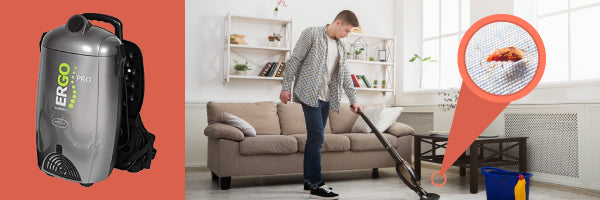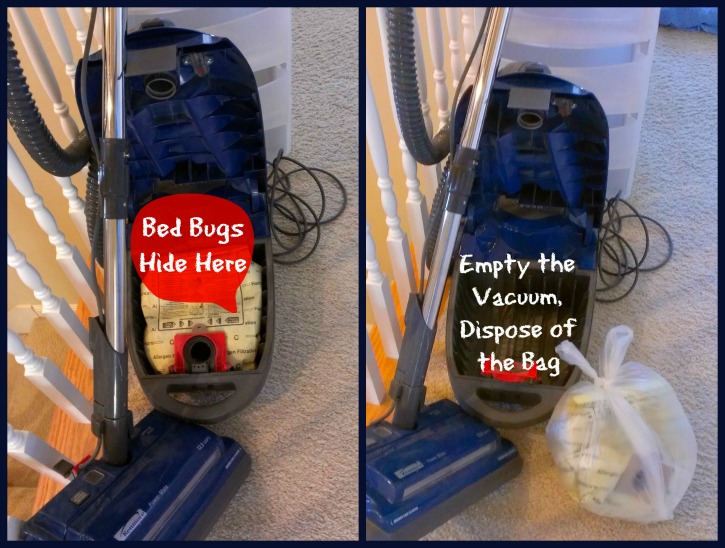Yes, bed bugs can live in a vacuum cleaner for several months, surviving without food. Although the suction may kill them, some bugs can escape and hide in the vacuum bag, potentially crawling out later.
Proper disposal and cleaning are essential after vacuuming for bed bugs to prevent their spread. It’s crucial to take precautions and securely dispose of the vacuum bag to avoid any potential re-infestation in your home. Regular maintenance and thorough cleaning of the vacuum cleaner are necessary steps to ensure effective bed bug removal.
Remember, thorough vacuuming alone may not completely eliminate a bed bug infestation, so it’s essential to consider additional treatment methods.
Bed Bug Basics Information
Life Cycle And Habits
Bed bugs go through different stages – egg, nymph, and adult. They feed on blood and can survive for several months without feeding.
Common Hiding Spots
- Bed bugs hide in cracks, crevices, mattresses, and furniture.
- They can also be found behind wallpaper, electrical outlets, and picture frames.
Bed bugs may end up in vacuum cleaners, but can they survive there?
Yes, bed bugs can live in a vacuum cleaner for up to six months, especially if they find a way to escape the vacuum bag or filter.
If bed bugs are sucked up by the vacuum, it is crucial to properly clean and dispose of the vacuum contents to prevent their spread.
Remember to inspect and clean your vacuum thoroughly after each use to avoid any potential infestations.

See here: Does Dry Cleaning Remove Bed Bugs
Vacuum Cleaners And Bed Bugs
Bed bugs are resilient pests that can be notoriously difficult to eradicate. When dealing with a bed bug infestation, homeowners often turn to vacuum cleaners as a means of control. However, it’s important to understand the effectiveness of vacuum cleaners in eliminating bed bugs and whether these pests can survive inside the vacuum itself.
Can Bed Bugs Survive Inside?
Bed bugs can survive inside vacuum cleaners. While the suction of a vacuum can capture bed bugs, the pests may not necessarily die inside the vacuum. In fact, studies have shown that bed bugs can survive for a significant period within the confines of a vacuum cleaner.
Vacuum Components At Risk
When bed bugs are vacuumed up, they can potentially find refuge in various components of the vacuum. These components include the hose, brush bristles, and even the filter or bag. This means that the pests might escape the suction and take up residence in these parts, posing a risk of reinfestation when the vacuum is used again.
Survival Tactics Of Bed Bugs
Bed bugs can survive in a vacuum cleaner, as they can navigate into the hose or cling to the bristles. Once inside, they may survive for up to six months. After vacuuming, it’s crucial to clean the vacuum thoroughly and dispose of the bag outside to prevent any potential spread of bed bugs.
Resilience In Adverse Conditions
Bed bugs are known to be resilient creatures that can adapt to various adverse conditions, making them difficult to eradicate. They are capable of surviving for several months without feeding and can thrive in both hot and cold temperatures. Bed bugs can also survive in a vacuum cleaner, making it challenging to use this method to eliminate them.
Escape Techniques
Bed bugs have several escape techniques that make them challenging to catch and eliminate. They are quick and can move from one place to another, making it hard to locate them. They can also hide in tiny crevices and cracks in walls, furniture, and floors, making it difficult to find them even with the best of intentions. Furthermore, they can detect chemicals and toxins, such as those found in insecticides, and avoid them. This makes it difficult to use chemical treatments to eliminate them. In summary, bed bugs are resilient and adaptable creatures that can survive in various adverse conditions, including vacuum cleaners. They have several escape techniques that make them challenging to eliminate, and they can detect and avoid toxins, making it difficult to use chemical treatments. Therefore, it’s essential to use a combination of non-chemical treatments, such as vacuuming, steaming, and heat treatments, to effectively eliminate bed bugs.

Vacuuming As A Control Method
When it comes to dealing with bed bugs, vacuuming is often considered a crucial control method. The process involves using a vacuum cleaner to physically remove bed bugs, their eggs, and nymphs from infested areas. While vacuuming can be effective, it’s important to understand its limitations and considerations.
Effectiveness In Removal
Vacuuming is an effective method for physically removing bed bugs from various surfaces, including carpets, mattresses, and furniture. It can help to reduce the bed bug population and limit their spread to other areas of the home. Using a vacuum with a strong suction and a crevice tool can aid in capturing bed bugs from cracks and crevices where they tend to hide.
Limitations And Considerations
Despite its effectiveness, vacuuming may not completely eliminate all bed bugs and their eggs, especially in hard-to-reach areas. It’s crucial to understand that vacuuming alone may not be sufficient to eradicate a bed bug infestation. Additionally, there is a risk of bed bugs or their eggs surviving inside the vacuum cleaner and potentially reinfesting the area if proper disposal methods are not followed.
Proper Vacuuming Techniques
Vacuuming is an essential part of bed bug control, as it helps to physically remove bed bugs from your home. However, it’s crucial to use proper vacuuming techniques to ensure that you effectively capture and dispose of these pests. Let’s explore the best practices, tools, and attachments for vacuuming to eliminate bed bugs from your living space.
Best Practices
- Regular Vacuuming: Vacuum your home frequently, focusing on areas where bed bugs are likely to hide, such as cracks, crevices, and seams.
- Vacuum Thoroughly: Ensure that you vacuum all surfaces, including mattresses, box springs, furniture, and carpets, to capture any bed bugs and their eggs.
- Dispose of Vacuum Contents: After vacuuming, immediately remove and seal the vacuum bag or empty the canister contents into a plastic bag for disposal.
Tools And Attachments
Utilizing the right tools and attachments can significantly improve the effectiveness of vacuuming for bed bugs. Here are some essential tools and attachments to consider:
| Tool/Attachment | Usage |
|---|---|
| Crevice Tool: | Use this narrow attachment to reach into tight spaces where bed bugs may be hiding, such as seams and joints. |
| Brush Attachment: | Effective for dislodging bed bugs and eggs from fabric surfaces like mattresses and upholstery. |
| Extension Wand: | Enables you to access difficult-to-reach areas, such as ceiling corners and baseboards, where bed bugs may be present. |
Post-vacuuming Protocol
After vacuuming up a bed bug infestation, it’s important to follow a post-vacuuming protocol to ensure that any remaining bed bugs are eliminated and that you don’t accidentally spread the infestation to other areas of your home. One common concern is whether bed bugs can live in a vacuum cleaner. The good news is that bed bugs cannot survive in a vacuum cleaner for long periods of time, but it’s still important to take precautions when cleaning and disposing of the vacuum contents.
Cleaning The Vacuum
After vacuuming up bed bugs, it’s important to clean the vacuum thoroughly to ensure that any remaining bed bugs or eggs are eliminated. Here are some steps to follow:
- Remove the vacuum bag or canister and dispose of it in a sealed plastic bag.
- Wipe down the inside of the vacuum with hot, soapy water and a cloth.
- Use a small brush or toothbrush to clean any crevices or hard-to-reach areas.
- Let the vacuum dry completely before using it again.
Disposal Of Vacuum Contents
It’s important to dispose of the vacuum contents in a way that prevents bed bugs from spreading to other areas of your home. Here are some tips:
- Dispose of the vacuum bag or canister in a sealed plastic bag.
- Place the sealed bag in an outdoor trash can, away from your home.
- Consider spraying the bag with insecticide before disposing of it.
- Wash your hands thoroughly after handling the vacuum contents.
By following these post-vacuuming protocols, you can help ensure that any remaining bed bugs are eliminated and that you don’t accidentally spread the infestation to other areas of your home.
Alternative Bed Bug Eradication Methods
When it comes to dealing with bed bugs, it’s essential to consider alternative eradication methods to ensure thorough removal of these pesky insects. In addition to traditional pesticide treatments, there are other effective methods that can be used to combat bed bug infestations. Let’s explore some alternative bed bug eradication techniques that have shown promising results.
Heat Treatment
Heat treatment is a non-chemical approach to eliminate bed bugs and their eggs. This method involves raising the temperature in infested areas to levels that are lethal to bed bugs, typically between 117°F and 122°F. The sustained exposure to high temperatures effectively eradicates bed bugs at all stages of their lifecycle, making it a reliable alternative to chemical treatments.
Chemical Treatments
Chemical treatments, such as insecticides and pesticides, have long been used to combat bed bug infestations. However, it’s important to note that these treatments should be administered by professionals to ensure safety and efficacy. Chemical treatments can be effective when used in conjunction with other eradication methods, but they should be approached with caution due to potential health and environmental risks.
Preventing Reinfestation
Bed bugs can survive in a vacuum cleaner, but they are unlikely to live long. It’s crucial to empty the vacuum outside immediately after use to prevent reinfestation. Regular vacuuming helps control bed bugs by capturing and removing them from your living space.
Regularly inspect your living areas for any signs of bed bugs, especially after vacuuming. Maintaining a clean environment is crucial to prevent bed bug reinfestation.
Regular Inspections
- Inspect your bedding, furniture, and walls for any signs of bed bugs.
- Check the vacuum cleaner for any bed bugs that may have survived.
- Monitor for any bites or skin irritations that could indicate a bed bug presence.
Maintaining A Clean Environment
- Regularly vacuum and clean your home to eliminate potential bed bug hiding spots.
- Wash bedding, curtains, and clothing in hot water to kill any bed bugs or eggs.
- Reduce clutter in your living space to minimize hiding places for bed bugs.
By following these preventive measures, you can effectively reduce the risk of bed bug reinfestation in your home.
How Long Can Bed Bugs Live In A Vacuum?
Bed bugs can live in a vacuum cleaner for up to 6 months due to their survival abilities.
Can Bed Bugs Be Transferred By Vacuum?
Yes, bed bugs can be transferred by vacuum if not properly disposed of after vacuuming.
How Do You Clean A Vacuum After Bed Bugs?
To clean a vacuum after bed bugs, spray infested areas, vacuum thoroughly, clean vacuum with hot soapy water, and dispose of bag securely outside.
Can Bugs Survive In Vacuum Cleaner?
Yes, some bugs can survive in a vacuum cleaner. They may get caught in the hose or on the brush bristles, then be transported to new locations. Some bugs can survive in the vacuum for months, even without food.
Can Bed Bugs Survive In A Vacuum Cleaner?
Yes, bed bugs can survive in a vacuum cleaner for a short period.
Last Word
While vacuuming can capture bed bugs, they can survive in the cleaner for months. To prevent reinfestation, dispose of the vacuum bag properly and clean the vacuum thoroughly. Regular cleaning and proper disposal are essential after vacuuming for bed bugs.

